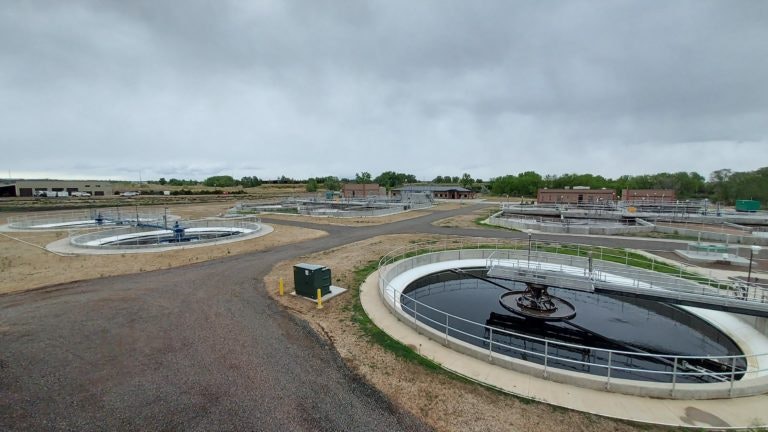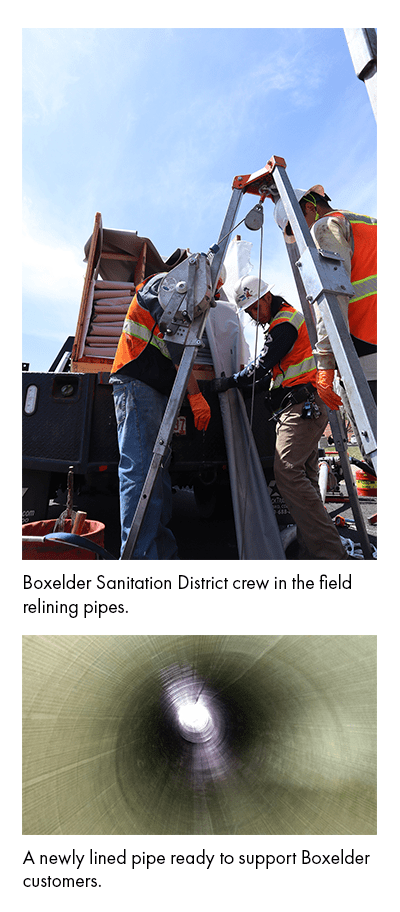How the District Approaches Aging Infrastructure

Wastewater treatment is a vital component to a healthy and vibrant community. As your sanitation services provider, we’ve been a trusted partner of northern Colorado residents for more than 50 years. What began as a District with less than 100 accounts in 1965 now comprises a vast system of infrastructure totaling more than 100 miles of sewer lines. That’s quite a large increase in scale over the years!
At Boxelder Sanitation District, it is our responsibility to provide reliable wastewater service to our community and we’re able to do that with constant and strategic maintenance of our system’s infrastructure. It’s not without its costs, and it isn’t always easy, but it sure keeps things flowing.
If you’ve ever wondered what makes up our infrastructure, how we maintain it, and why it matters to you, keep reading.
Wastewater infrastructure is largely the piping—or sewer lines—that connect your residence with our treatment facility. From the moment you pour something down the drain to when it arrives at the facility, your waste has traveled through a network of pipes that also collects from other residential and commercial properties in the community. Specifically, 1,940,000 gallons of wastewater is processed daily by the District.
The District’s infrastructure extends beyond the sewer lines. It also includes the treatment plant, pumping stations, and pressure sewer lines. Together, those physical components work hard to ensure all the waste that is collected every day is treated and recycled into clean water that is returned to the river. But there’s more! In order to maintain our infrastructure, the District also has a fleet of vehicles, specialized maintenance equipment, and buildings used by the staff. Wastewater treatment is a complicated business.
With all of these physical and mechanical pieces of equipment working every day—and often around-the-clock—to treat the District’s wastewater, when is there ever time to maintain that equipment and how does that happen?
At the District, we pride ourselves in the efficient and proactive maintenance of our infrastructure. According to a recent report, 62% of sanitation utility services agreed that proactive asset management plans helped maintain their equipment (and their bottom line), rather than reactive response. Count us in that mix.
The immediate answer to that is, “It keeps things flowing.” But perhaps it’s helpful not to look at the District’s infrastructure as something that simply provides a service—it’s something you “own” an interest in.
Infrastructure costs are carefully considered by the District each year to determine the rates that customers pay, and in turn, we operate in the most efficient and cost-effective way possible to keep rates as low as possible. You can play a part in mitigating unexpected maintenance projects by being mindful of what you put down the drain. By avoiding sending fats, oils, greases, disposable wipes, and other unwanted objects down your pipes, you can help keep things flowing smoothly and keep operating costs—like maintenance—down.

The District has developed very specific standard operating procedures to ensure the efficient and timely maintenance of infrastructure, so services aren’t interrupted. This includes considerations like how items are inspected, what routine maintenance is required, and how that will impact the overall system.
Our proactive maintenance program allows us to get more mileage from our infrastructure and reduce the need for costly replacements. As you can imagine, replacing something like sewer lines can be quite an undertaking. As a responsible District, we evaluate all of our infrastructure—from sewer lines to our treatment plant to determine if components need to be repaired or replaced as they get older so that we can keep things flowing.

In the last eight years, the District has been actively rehabilitating sewer lines that have aged to the point that they are no longer reliable. This rehabilitation has been done by using the latest pipe lining technology, which involves the installation of a new pipe within an old pipe. Doing so avoids tearing up streets, inconveniencing residents, and causing prolonged service disruptions.
In addition to this, we have also developed a comprehensive Capital Improvement Plan that projects into the future to predict infrastructure upgrades and replacement, allowing us to responsibly plan for costs. This also affords us the foresight to accommodate future growth, including the installation of new sewer lines, lift stations, and treatment plant upgrades.
We review the plan every year to ensure we’re on track and focused on project timelines.
The most important and impactful thing a District customer can do to help sustain aging infrastructure is to follow the general guidelines of what you shouldn’t flush down your toilet. The other way you can help is to stay an active and informed member of the District. You can do that by staying tuned to our blog, keeping up-to-date with our news and notices, and reaching out when you have a question or concern.
